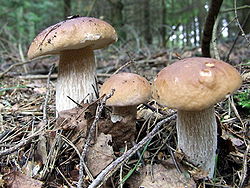Top Qs
Timeline
Chat
Perspective
Boletus
Genus of fungus From Wikipedia, the free encyclopedia
Remove ads
Boletus is a genus of mushroom-producing fungi, comprising over 100 species. The genus Boletus was originally broadly defined and described by Carl Linnaeus in 1753, essentially containing all fungi with hymenial pores instead of gills. Since then, other genera have been defined gradually, such as Tylopilus by Petter Adolf Karsten in 1881, and old names such as Leccinum have been resurrected or redefined. Some mushrooms listed in older books as members of the genus have now been placed in separate genera. These include such as Boletus scaber, now Leccinum scabrum, Tylopilus felleus, Chalciporus piperatus and Suillus luteus. Most boletes have been found to be ectomycorrhizal fungi, which means that they form a mutualistic relationship with the roots system of certain kinds of plants.[3] More recently, Boletus has been found to be massively polyphyletic, with only a small percentage of the over 300 species that have been assigned to Boletus actually belonging there and necessitating the description and resurrection of many more genera.[2][4][5][6]
The name is derived from the Latin term bōlētus 'mushroom' from the Ancient Greek βωλίτης, bōlitēs,[7] ultimately from βῶλος, bōlos 'lump' or 'clod'.[8] However, the βωλίτης of Galen is thought to have been the much prized Amanita caesarea.[9]
Remove ads
Phylogenetic tree of Boletus
Summarize
Perspective
|
B. pallidus= Imleria pallida (Frost 1873) A.Farid, A.R.Franck & J.Bolin 2020 | |
source:[10]
Remove ads
Edibility
The genus Boletus contains many members which are edible, such as Boletus edulis, Boletus aereus and Boletus barrowsii.
Boletes with red pores may be toxic.[11]
See also
- Bolete eater, a fungal parasite of various Boletus species
- List of Boletus species
References
External links
Wikiwand - on
Seamless Wikipedia browsing. On steroids.
Remove ads

